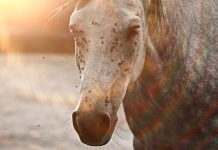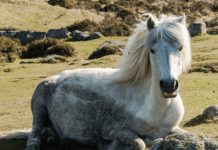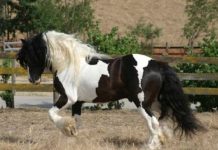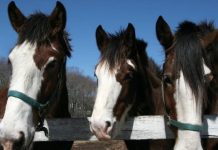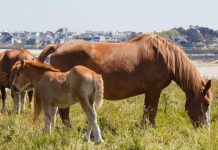Despite its small size of 160 cm on average, the Ardennais weighs up to a ton. But that in no way prevents the strong horses from also being sporty: because the Ardennais is an extremely lively horse that is willing to work.
Above all, the bulk of the Ardennes makes it a very strong horse, which is why it used to be very popular as a warhorse and on the field.
Another advantage of the heavy draft horses is their robust nature. The Ardennais is very easy to care for, friendly and hardy. Neither wind and weather nor illnesses can harm the good-natured animal and its nature is also extremely relaxed and friendly.

Today, the Ardennes horse is mainly used as a battle horse, but it is also occasionally used as a draft animal. Since machines have taken over the working areas of the heavy cold-blooded horses over time, horses are only encountered in agriculture in exceptional cases. In forestry, however, the strong Ardennais is still used today to transport heavy trees out of the forest. You can still admire the power of the Ardennes at events such as knight shows or parades.
In addition to their tasks in fattening and forestry, Ardennes are also used as leisure horses. Because the friendly giants are active and like to move, but are not too spirited, which is why they are particularly suitable for beginners and anxious riders. The reliable and good-natured character makes the Ardennais a unique companion that does not let its rider down even in tricky situations.
History of the Ardennais

The history of the Ardennais begins in France, but the origin of the breed goes back much further: The Ardennais is a descendant of the Solutre horse, a horse breed that inhabited Europe around 20,000 BC.
Even the Roman legions recognized the advantages of heavy horses and used them for attacks. Even Julius Caesar is said to have had a great enthusiasm for the sumptuous war horses.
Even in the Middle Ages, the powerful horses were used for war. Not only did they appear threatening due to their mass, but the strong horses could also carry the knights and their armor without any problems and were still agile and happy to move. During the Crusades, Arabs and other oriental horse breeds were crossed with Ardennais horses to make the strong horses a little lighter. Napoleon also recognized the advantages of the breed and used the heavy animals as artillery horses.
Later, in the 19th century, people wanted to use Ardennais more often in the fields and as draft horses, which is why the heavy Brabant horses were included in the breed. In this way, the strong side of the Ardennais, who were willing to work, was emphasized again.
Today, the Ardennais is mainly used as a battle and draft horse.
Where does the Ardennais get its name from? From the Ardennais mountain range, which has a Belgian, French and Dutch part. The heavy horse breed was at home here and was also traditionally bred.
The Ardennais is also the origin of several horse breeds: those of the Auxios, the Palatinate-Ardennes, the Sweden-Ardennes and the Trait du Nord.
The Ardennais in film and television
In the film adaptation of the bestseller The Medicus, it is an Ardennais who pulls the heavy medieval carriage of the traveling barber. In 11th-century England, young Rob Cole (Tom Payne) discovers that he has the gift of sensing other people’s illnesses and imminent deaths. When his mother dies, she leaves young Rob orphaned, whereupon the barber (Stellan Skarsgard) takes him in. Driven by his fate, the Rob later decides to seek out the great physician and scholar Ibn Sina (Ben Kingsley) in Persia to study with him.
Advice on keeping Ardennais

Every horse is unique, no matter what breed it belongs to. And no matter how long or short the pedigree is, every horse has similar needs, such as those for food, exercise, and social contact. These must be satisfied in order to enable a happy horse life. However, depending on what the breed of horse was originally bred for, there are many different characteristics: some are bred to be sport horses and need more exercise than others, and some are more leisurely workhorses.
Just remember that the classification into draft, warm-blooded and thoroughbreds is made primarily on the basis of temperament. With our horses, too, it always depends on the individual creature. Because not all Shire Horse are strong-nerved giants and not every Arabian is a tenacious racer.








